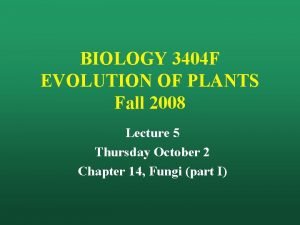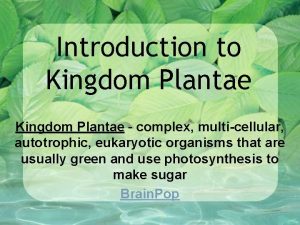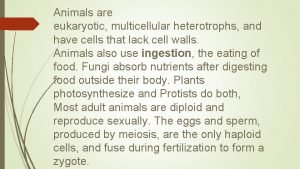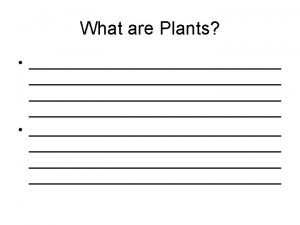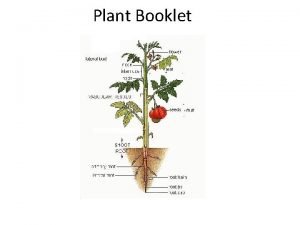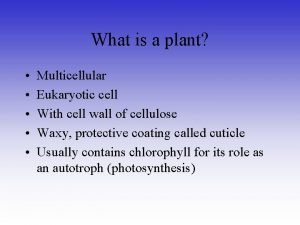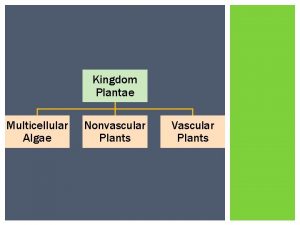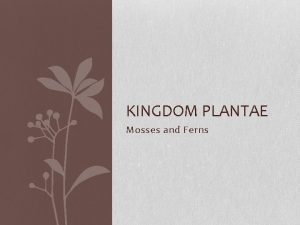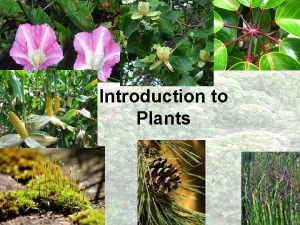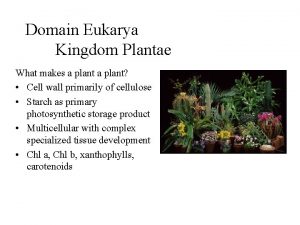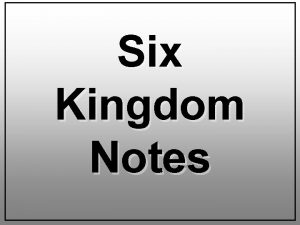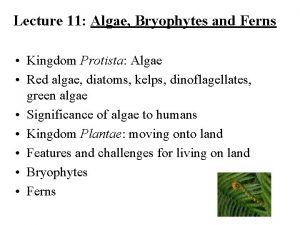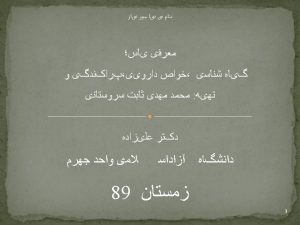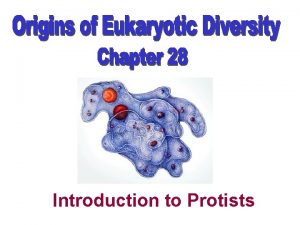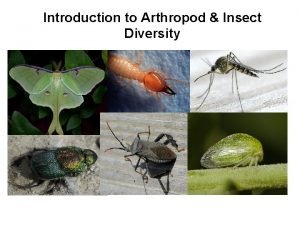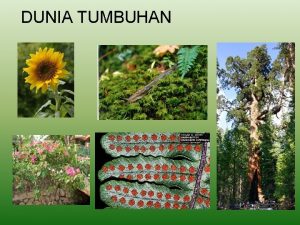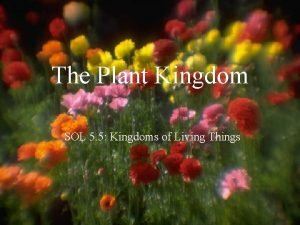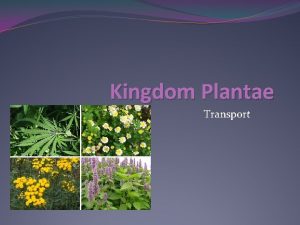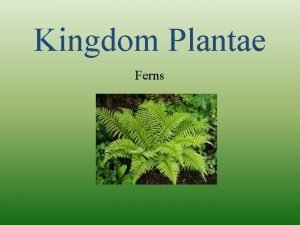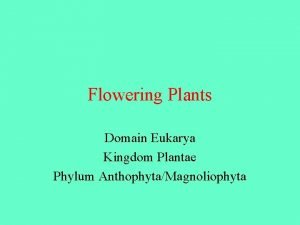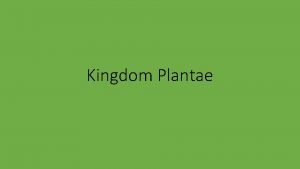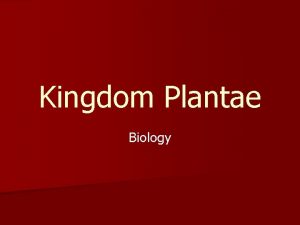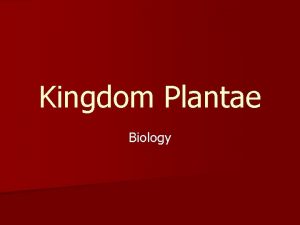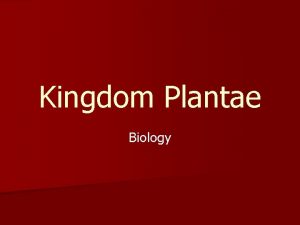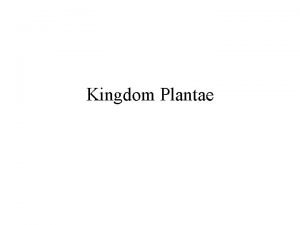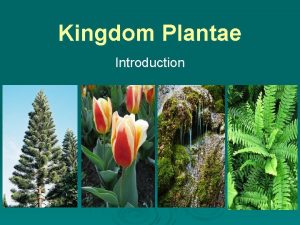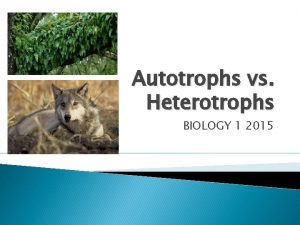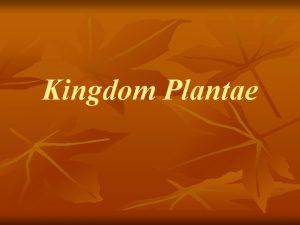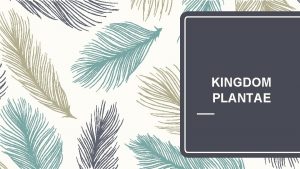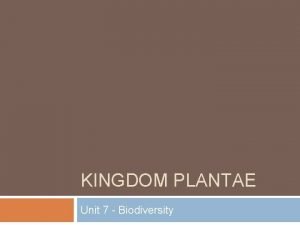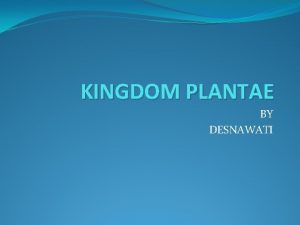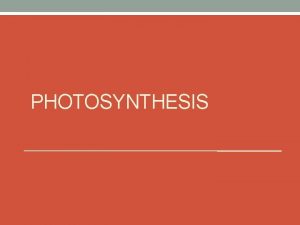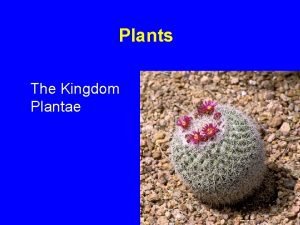KINGDOM PLANTAE Multicellular eukaryotes autotrophs sporic meiosis life



































- Slides: 35

KINGDOM PLANTAE Multicellular, eukaryotes, autotrophs, sporic meiosis life cycle

RESPONSES • TROPISMS • Plant growth response to a stimulus – 1. Positive – grows with/toward stimulus – 2. Negative – grows against/away from stimulus – 3. Phototropism – growth response to light – 4. Thigmotropism – growth response to touch – 5. Hydrotropism – growth response to water – 6. Geotropism/Gravitropism – growth response to gravity/Earth

RESPONSES cont… • Taxis/Nastic Response • Plant movement response to a stimulus – 1. Phototaxis – movement response to light • Ex. Helianthus annuus (sunflower) – 2. Thigmotaxis – movement response to touch • Ex. Dionaea muscipula (Venus fly trap)

Bryophytes Seedless Nonvascular • • Mosses Liverworts Hornworts Important Human Uses – Significant component of plant biodiversity (~16, 000 species) – Human uses Peat fuel & Peat Moss (used for heat/fuel)

Seedless Vascular Plants ferns & fern allies • A. Evolution of vascular plants – Cooksonia = oldest vascular plant fossil – Vascular Plant Body 1. Root System DERMAL – Anchor plant – Absorb water & nutrients 2. Shoot/Tissue System - leaves photosynthesis - stems elevate leaves - Tissue Systems – 1. Dermal » Outer protective covering – 2. Ground » Main plant body = storage – 3. Vascular » Conducts water & nutrients » Xylem = conducts water » Phloem = conducts minerals VASCULAR GROUND SHOOT SYSTEM ROOT SYSTEM

Ferns & fern allies PHYLUM PTEROPHYTA “ptero” = winged

BODY BLADE FROND PETIOLE RHIZOME ROOTS • • Lamina – blade Petiole - stalk Rachis - axis “fiddleheads” cercinate venation – Unrolling of the head; uncurls while it develops – Protects the delicate leaf tip

Order Filicales • Most ferns belong to this order • 10, 500 species • REPRODUCTION – Some have separate vegetative & fertile leaves – Sori = structures that hold spores – Multiflagellate sperm – Some only reproduce asexually

Conifers “gymnos” = naked GYMNOSPERMS - 1 ST PLANTS TO HAVE SEEDS “sperm” = seed

Reproduction • Male – Microsporangia make many spores • Microspores are the male gamete (sperm) • Female – Megasporangia make 4 megaspores • Megaspores are the female gamete (egg) • Fertilization – Fertilization of the egg produces a zygote (2 N) – Stores tissue inside the seed for food – Seed is dispersed

Fruiting plants ANGIOSPERMS

CARPEL Stigma Style Ovary stigma style anther petals sepals filament ovary Receptacle stalk STAMEN Anther Filament

Monocots • Parallel venation • Multiples of 3

(eu)dicots • Palmate venation • Multiples of 4 or 5

Fertilization & Fruits • Fruit Development • Double Fertilization – Ovule • 2 sperm fuse with the • Develops into seed (2 N) same egg – Integument = seed coat • 1 ST sperm + egg/N = – Endosperm = food reserve zygote (2 N) – Ovary • Develops into fruit • 2 ND sperm + egg/2 N = • Fruit completely encloses seed endosperm (3 N) • Fruit is a food source/reward for animals/transportation/disper sal

Outcrossing/Cross Pollinating Phases Dichogamy • Male & female parts are mature at the same time • a. Staminate (male dominant) • Male & female parts mature at different times • A. Protandrous – Carpels reflexed/bent to one side – Stamens produce pollen • B. Carpellate (female dominant) – Carpels swing up above – Stigma opens to receive pollen – “andro” = male – Stamens & anthers mature 1 ST • B. Protogynous – “gyno” = female – Carpels & stigmas mature 1 ST

Adaptations of species with bisexual flowers (aka “perfect flowers”) • Physical separation between the male & female parts • Self-incompatibility – Pollen from the same flower will not be able to fuse with the egg to germinate and produce any seeds. • e. g. Plums – must have 2 different varieties to get fruit!

Adaptations of species with Unisexual Flowers Monoecious Dioecious • “mono” = one • Male and female flowers are separate, but on the same plant • “di” = two • Male and female flowers are on completely different plants! • Guarantees outcrossing

Inbreeding (self-pollination) • About ½ of species in the temperate zones selfpollinate • Usually have small less-conspicuous(showy) flowers • Advantages – 1. saves energy • Can produce more seeds instead of colors, different maturation times, etc. – 2. genotype suited to a specific habitat • “if it ain’t broke… don’t fix it!” – 3. lack of pollinators • Cold environment not many birds/insects/animals

Families of Flowering plants

Daisies biggest eudicot family FAMILY ASTERACEAE 22, 000 species

Structure • Tiny flowers arranged into a huge compound head • “capitulum” – compound head of many smaller flowers • Fused anthers with a stigma sticking out the top • 2 fused carpels make up the inferior ovary • 5 fused stamens • 5 fused petals

Ray Flower Disk Flower

CAPITULUM Ray Flower Disk Flower Peduncle

Examples • Dandelions – Have only ray flowers • Thistles – Have only disk flowers • Sunflowers – Have both disk & ray flowers

Orchids biggest monocot family FAMILY ORCHIDACEA 24, 000 species

Structure • Stamen fused with style and stigma to form a column

Plant Pollinators Beetle-Pollinated Bee-Pollinated • Dull colors • Bright showy petals (blue & yellow) • Distinctive markings • Strong fragrances • Landing platform • Nectaries at the base of a corolla tube – (white/cream/green/darker) • Strong odors – (fruity/spicy/foul) • Inferior ovary to protect ovules • Edible parts

Plant Pollinators Cont… Butterfly Pollinated Moth Pollinated • Long tube with nectar at the bottom (specific to mouth parts) • Showy colors (red & orange) • weak fragrances • Open at night • Emit fragrance after sunset • Long tube with nectar at the bottom (specific to mouth parts) • White or pale colors

Plant Pollinators Cont… Bird Bat • Often red (visible to birds) • Usually odorless • Large amount of thin nectar (high energy) • Dull colors • Strong odors (fruity or musty) • Some open only at night • Large amount of nectar

Plant Pollinators Cont… Wind • Dull or colorless • Petals small or absent • Odorless and no nectar

PLANT HORMONES -Small organic molecules -Highly specific chemical agents -Only produce certain results -Function in tiny concentrations -A little goes a long way -Regulate growth & development

Auxins Cytokinins • Produced in the shoot tips • Stimulate cell elongation Auxin production (NOT DIVISION) • Only moves down through plant • Indolacetic Acid (IAA) • Produced in the root tips • Stimulates cell division • Only moves up through the plant – Most common natural auxin – Important in fruit growth Cytokinin production

Ethylene • Only gas hormone in plants • Inhibits cell expansion • Promotes fruit ripening – Change in color – softening • Promotes leaf drop

extras Abscisic Acid Gibberellins • Inhibitors • Restrains plant growth • Promotes growth – Cell division & elongation • Promotes seed germination – Fertilized seed can start to grow
 Sporic meiosis
Sporic meiosis Plant - multicellular eukaryote of the kingdom plantae
Plant - multicellular eukaryote of the kingdom plantae Similarities between protists and fungi
Similarities between protists and fungi Plantae kingdom drawing
Plantae kingdom drawing Domain eukarya kingdom protista
Domain eukarya kingdom protista Images of multicellular organisms
Images of multicellular organisms All animals are multicellular heterotrophs
All animals are multicellular heterotrophs Are plants multicellular eukaryotes
Are plants multicellular eukaryotes Plant tissue
Plant tissue Are plants multicellular eukaryotes
Are plants multicellular eukaryotes Are cell walls prokaryotic or eukaryotic
Are cell walls prokaryotic or eukaryotic Old kingdom middle kingdom new kingdom
Old kingdom middle kingdom new kingdom Nnn ruled
Nnn ruled Youtube egypt
Youtube egypt Old kingdom middle kingdom new kingdom
Old kingdom middle kingdom new kingdom Distinguishing characteristics of plantae
Distinguishing characteristics of plantae Kingdom plantae vascular and nonvascular
Kingdom plantae vascular and nonvascular Biology
Biology Disadvantages of coniferophyta
Disadvantages of coniferophyta Character of plantae
Character of plantae Lycodiophyta
Lycodiophyta Fruits one
Fruits one Kingdom monera protista fungi plantae animalia
Kingdom monera protista fungi plantae animalia Characteristics of the kingdom plantae
Characteristics of the kingdom plantae Archaebacteria characteristics chart
Archaebacteria characteristics chart Protista prokaryotic
Protista prokaryotic Green algae structure
Green algae structure Kingdom plantae cladogram
Kingdom plantae cladogram Subkingdom of plants
Subkingdom of plants Kingdom plantae
Kingdom plantae Kingdom plantae chart
Kingdom plantae chart Gambar daur hidup paku
Gambar daur hidup paku Parts of flower
Parts of flower How do plantae get nutrients
How do plantae get nutrients Ferns
Ferns Flowering plants domain
Flowering plants domain
